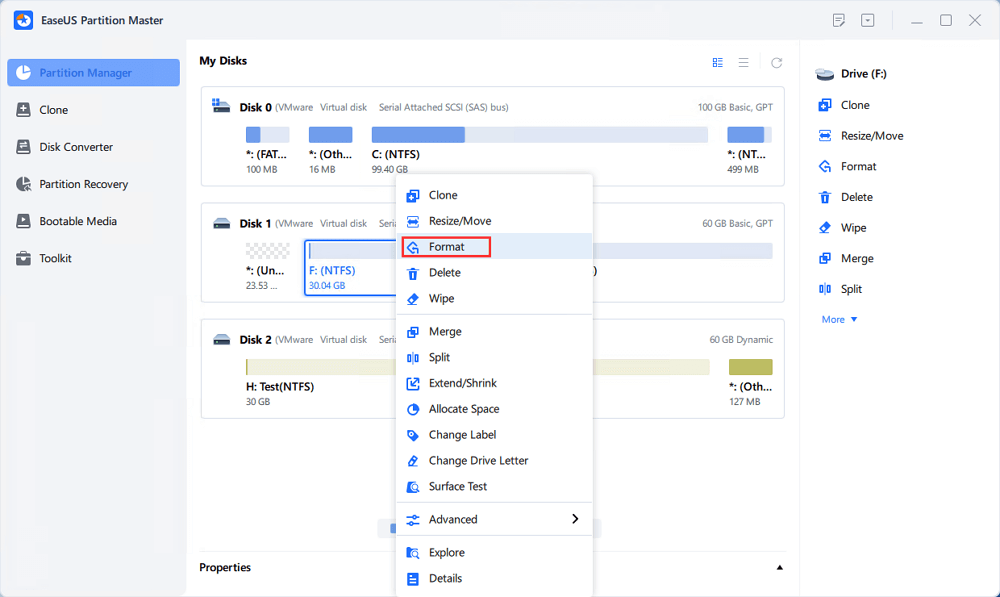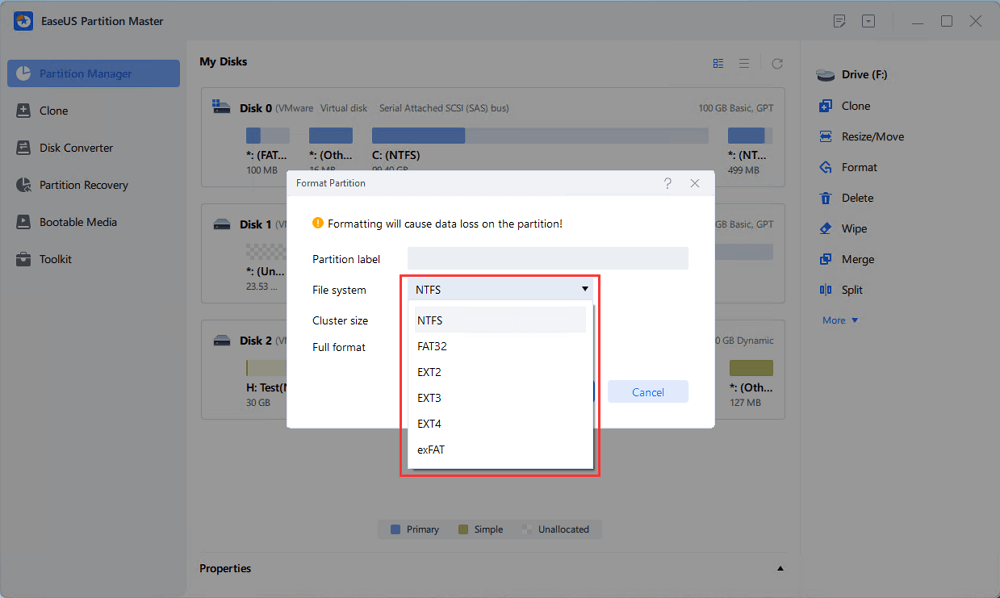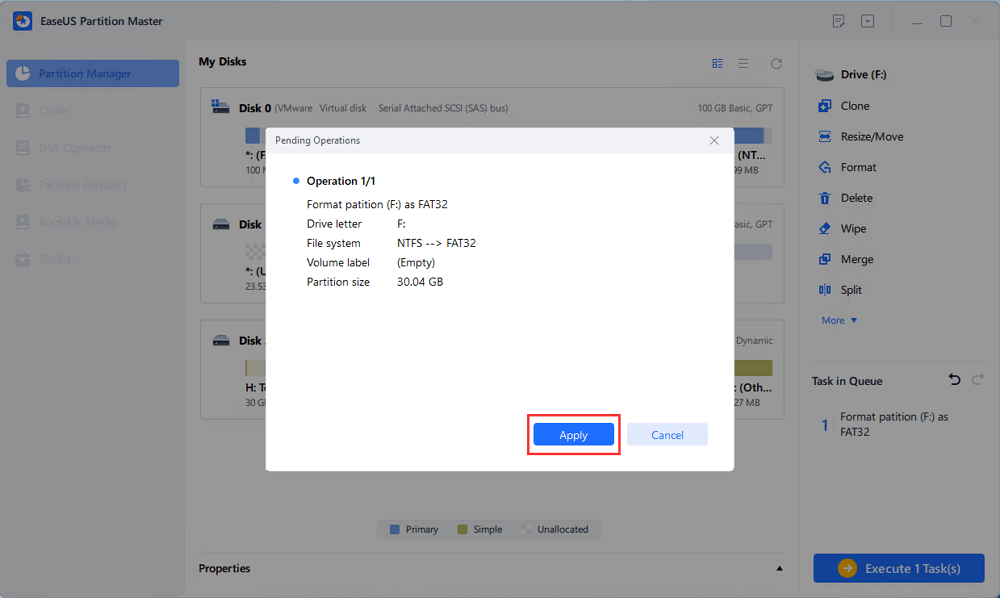Start Your Free Trial!
Sign up to our newsletter, stay updated on news and exclusive offers from EaseUS. Don't worry, if you change your mind, you can unsubscribe at any time, free of charge. We value your privacy (Privacy Policy).
Page Table of Contents
How to Format 64 GB USB to FAT32 - 2 TipsHOT
Why Can't I Format a USB Larger Than 32 GB to FAT32?HOT
ConclusionHOT
FAQs of How to Format 64 GB USB to FAT32HOT
About the Author
Hot Topics
Updated on Apr 28, 2025
Windows has a built-in restriction that prevents formatting drives larger than 32GB to FAT32 using standard tools like File Explorer or Disk Management. When you try to format a USB or disk that is larger than 32 GB, you may receive an error stating that "the volume is too big for FAT32."
In this article, EaseUS will guide you through how to format 64GB, 128GB, or larger USB drives to FAT32 using various methods, including third-party software and command-line utilities.
Third-party formatting tools like EaseUS Partition Master Professional can provide an easy solution to format USB drives larger than 32GB to FAT32. By applying this popular disk formatter, you can break Windows' 32GB capacity limit and successfully convert 64GB SD card, USB, hard drive, and SSD to FAT32.
Refer to the instructions below to begin:
Step 1. Run EaseUS Partition Master, right-click the hard drive partition you intend to format and choose "Format".

Step 2. In the new window, set the Partition label, File system (NTFS/FAT32/EXT2/EXT3/EXT4/exFAT), and Cluster size for the partition to be formatted, then click "OK".

Step 3. Then you will see a warning window, click "Yes" in it to continue.

Step 4. Click the "Execute 1 Task(s)" button to review the changes, then click "Apply" to start formatting the partition on your hard drive.

Beyond formatting 64 GB USB to FAT32, this best USB format tool can also get you covered in versatile scenarios:
If you prefer not to use third-party software, use Windows Command Prompt or PowerShell to format your USB drive. However, this method may take significantly longer than using dedicated software.
Using Command Prompt
Step 1. Press Win + X and select "Command Prompt."
Step 2. Type diskpart and press "Enter."
Step 3. Type list disk and press "Enter" to see all connected drives, then use the following commands to format:
Type format fs=fat32 quick
Step 4. Type quit and hit "Enter" after the process is done.
This method may take a long time for larger drives (up to several hours).
Using PowerShell
PowerShell can also be used similarly:
Step 1. Press Win + X and select "Windows PowerShell."
Step 2. Type format /FS:FAT32 X: (replace X with your drive letter) and press "Enter."
Again, this method may be time-consuming for larger drives. Don't hesitate to share this helpful guideline with your friends:
Below are the main reasons why you can't format USB to FAT32 in Windows:
1️⃣Size Limitation: Windows has a built-in restriction that prevents formatting drives larger than 32GB to FAT32 using standard tools like File Explorer or Disk Management. This limitation means that when you try to format a 64GB USB drive, the FAT32 option may not be available, or you may receive an error stating that "the volume is too big for FAT32."
2️⃣File System Compatibility: If the USB drive was previously formatted with a different file system (like NTFS), it needs to be reformatted completely to FAT32. This process can sometimes lead to complications if the drive is also in a corrupted state or has been affected by malware.
3️⃣Write Protection: If the USB drive has a physical write protection switch or has been set to read-only mode, you will not be able to format it until that protection is removed.
This post discussed four methods of formatting a USB drive larger than 32GB to FAT32, which includes third-party software for ease and speed or using command-line tools for those who prefer built-in options despite their limitations.
For most users seeking convenience without extensive technical knowledge, third-party tools like EaseUS Partition Master or the FAT32 Format Tool are recommended due to their user-friendly interfaces and quick formatting capabilities.
No matter which way you choose, always ensure that important data is backed up before proceeding with any formatting operation, as this process will erase all existing data on the drive.
If you have more questions to ask about how to format USB larger than 32 GB to FAT32 in Windows, you can follow us to explore additional information in this section:
1. How do I convert a 64 GB SD card to FAT32?
By following the methods above, you can easily break the Windows limitations and format a 64 GB SD card to FAT32.
📢More Details: How to Format 64 GB SD Card to FAT32
2. Why does FAT32 have a 4GB file size limit?
The 4GB file size limit of FAT32 arises from its design based on a 32-bit architecture that cannot accommodate larger values. While this limitation poses challenges in modern computing environments where large files are commonplace, various workarounds exist.
3. Which format is best for a USB drive larger than 32GB?
For most users with USB drives larger than 32GB:
In summary, exFAT is generally regarded as the best option for USB drives larger than 32GB due to its flexibility in handling large files while maintaining good compatibility across various devices.
How Can We Help You
Roxanne is one of the main contributors to EaseUS and has created over 200 posts that help users solve multiple issues and failures on digital devices like PCs, Mobile phones, tablets, and Macs. She loves to share ideas with people of the same interests.
Cici is the junior editor of the writing team of EaseUS. She accepted the systematic training on computers at EaseUS for over one year. Now, she wrote a lot of professional articles to help people resolve the issues of hard drive corruption, computer boot errors, and disk partition problems.
It won't hot image your drives or align them, but since it's coupled with a partition manager, it allows you do perform many tasks at once, instead of just cloning drives. You can move partitions around, resize them, defragment, and more, along with the other tools you'd expect from a cloning tool.
Read MoreI love that the changes you make with EaseUS Partition Master Free aren't immediately applied to the disks. It makes it way easier to play out what will happen after you've made all the changes. I also think the overall look and feel of EaseUS Partition Master Free makes whatever you're doing with your computer's partitions easy.
Read MorePartition Master Free can Resize, Move, Merge, Migrate, and Copy disks or partitions; convert to local, change label, defragment, check and explore partition; and much more. A premium upgrade adds free tech support and the ability to resize dynamic volumes.
Read MoreIt won't hot image your drives or align them, but since it's coupled with a partition manager, it allows you do perform many tasks at once, instead of just cloning drives. You can move partitions around, resize them, defragment, and more, along with the other tools you'd expect from a cloning tool.
Read MoreI love that the changes you make with EaseUS Partition Master Free aren't immediately applied to the disks. It makes it way easier to play out what will happen after you've made all the changes. I also think the overall look and feel of EaseUS Partition Master Free makes whatever you're doing with your computer's partitions easy.
Read MoreRelated Articles
How to Bypass BitLocker Recovery Key on Dell Laptop Windows 11
![]() Shelly/2025/04/28
Shelly/2025/04/28
How to Use M.2 SSD As External Storage [Full Guide]
![]() Cici/2025/04/28
Cici/2025/04/28
Create D Drive from C Drive in 2 Simple Ways
![]() Oliver/2025/04/28
Oliver/2025/04/28
How to Remove Write Protection from SD Card and Format It
![]() Jean/2025/04/28
Jean/2025/04/28
EaseUS Partition Master

Manage partitions and optimize disks efficiently
Your best companion for disk partitioning, MBR to GPT/GPT to MBR conversion,even OS migration
CHOOSE YOUR REGION
Start Your Free Trial!
Sign up to our newsletter, stay updated on news and exclusive offers from EaseUS. Don't worry, if you change your mind, you can unsubscribe at any time, free of charge. We value your privacy (Privacy Policy).
Start Your Free Trial!
Sign up to our newsletter, stay updated on news and exclusive offers from EaseUS. Don't worry, if you change your mind, you can unsubscribe at any time, free of charge. We value your privacy (Privacy Policy).